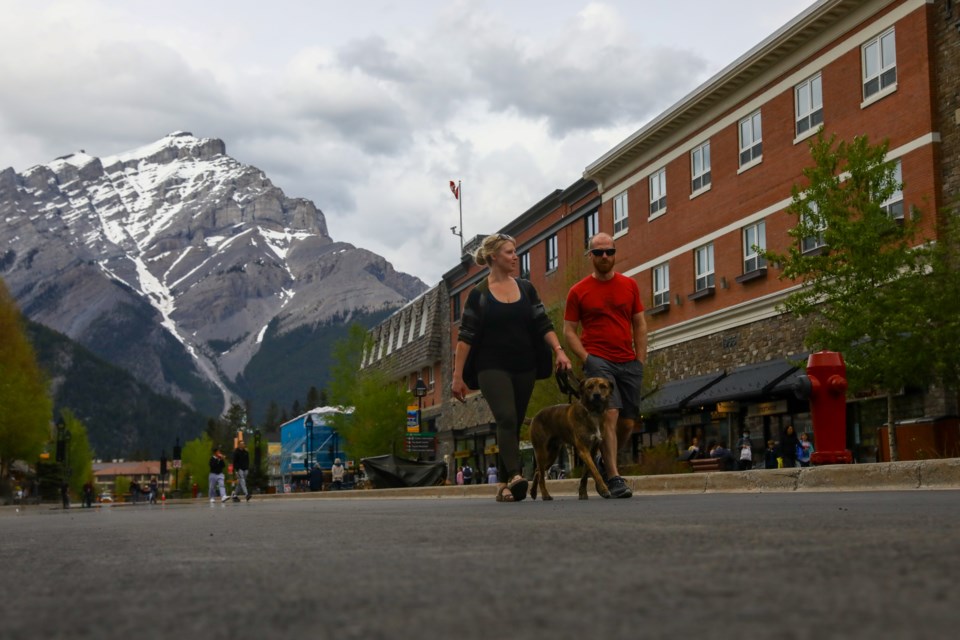BANFF – A vacant lot in the heart of downtown Banff is set to be developed as one of the last pieces of the puzzle in the federal government’s land takeover in the late 1990s.
The Bow Valley Credit Union, currently located at 216 Banff Ave., has applied to the Town of Banff for a development permit application for a new commercial-residential building on the vacant lot at 206 Banff Avenue next to the Rose & Crown building.
Dave Michaels, manager of development services for the Town of Banff, said the application, which involves transfer of commercial space under the growth cap, is expected to come before the Municipal Planning Commission (MPC) in June or July.
“This is currently a vacant lot on Banff Avenue and we’ve received a mixed-use building application for that location,” he told members of MPC on Wednesday (May 11).
In 1998, Parks Canada announced it would establish an environmental education centre on the 200 block of Banff Avenue by taking back commercial leases and eventually rezoning the area public service.
A service station was demolished and turned into a public park. Over time, Parks decided against taking back the lease of Caribou Corner. It now appears a deal has been reached with Bow Valley Credit Union.
“It was my understanding that those lots along that area were, over time, the leases were set to expire and that commercial space was to be transferred back,” said Commissioner Stavros Karlos during the MPC meeting. “Has that changed over time?”
Michaels said he believes this is the “last part of the puzzle.”
“The applicant is the credit union, which was the last remaining commercial property along that mid-block,” he said.
“The commercial floor area is being transferred from that site to this site that abuts Caribou Corner so there would be more contiguous parcels on the 200 block.”
MPC was curious whether that meant the building currently housing the credit union would be demolished.
“The building will no longer have a commercial lessee,” said Michaels. “I am not sure what Parks Canada will choose to do with it.”
Under a federally legislated growth cap put in place in 1998 to protect Banff National Park from environmental consequences of rampant development, the total commercial floor area permitted in the Banff townsite is 361,390 square metres.
This amount is based on development that already existed in the commercial districts of the town at the time, or that Parks Canada had approved prior to June 1998, plus an additional 32,516 square metres (350,000 square feet) of commercial floor space.
All of the commercial space was allocated by 2013 through a random lottery. Most allotments went to hotels, with the rest primarily being used for retail and restaurants.
The development allotment for the train station lands is the largest unbuilt allocation remaining. It’s anticipated the allocation will come up as part of Liricon Capital’s area redevelopment plan (ARP) for the railway lands.
The 2010 Banff National Park Management Plan says Parks Canada will continue the assembly of lands on the east side of the 200 block of Banff Avenue for “national park purposes.”
"Completing the assembly of the downtown lots is a positive step forward for Parks Canada in achieving this long-held objective," stated Parks Canada in a statement to the Outlook on May 17.
The new draft management plan, which has yet to be tabled in parliament, says the lands will be used for the development of facilities that enhance the connection of visitors in downtown Banff to the rest of the national park, and that foster knowledge and understanding of the ecology and human history of the area, and the larger regional ecosystem.
“Future redevelopment of these lands respects the location in the civic heart of the town, incorporates high standards for urban design, landscape architecture, and environmental sustainability, and reflects the town’s strong mountain aesthetic and architectural guidelines,” according to the document.
“This also extends to the public spaces associated with the development. In the near term, Parks Canada and the Town of Banff work together to foster a more dynamic and integrated open space within the downtown core."




